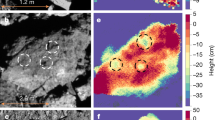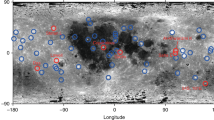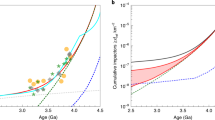Abstract
The barrage of comets and asteroids that produced many young lunar basins (craters over 300 kilometres in diameter) has frequently been called the Late Heavy Bombardment1 (LHB). Many assume the LHB ended about 3.7 to 3.8 billion years (Gyr) ago with the formation of Orientale basin2,3. Evidence for LHB-sized blasts on Earth, however, extend into the Archaean and early Proterozoic eons, in the form of impact spherule beds: globally distributed ejecta layers created by Chicxulub-sized or larger cratering events4. At least seven spherule beds have been found that formed between 3.23 and 3.47 Gyr ago, four between 2.49 and 2.63 Gyr ago, and one between 1.7 and 2.1 Gyr ago5,6,7,8,9. Here we report that the LHB lasted much longer than previously thought, with most late impactors coming from the E belt, an extended and now largely extinct portion of the asteroid belt between 1.7 and 2.1 astronomical units from Earth. This region was destabilized by late giant planet migration10,11,12,13. E-belt survivors now make up the high-inclination Hungaria asteroids14,15. Scaling from the observed Hungaria asteroids, we find that E-belt projectiles made about ten lunar basins between 3.7 and 4.1 Gyr ago. They also produced about 15 terrestrial basins between 2.5 and 3.7 Gyr ago, as well as around 70 and four Chicxulub-sized or larger craters on the Earth and Moon, respectively, between 1.7 and 3.7 Gyr ago. These rates reproduce impact spherule bed and lunar crater constraints.
This is a preview of subscription content, access via your institution
Access options
Subscribe to this journal
Receive 51 print issues and online access
$199.00 per year
only $3.90 per issue
Buy this article
- Purchase on Springer Link
- Instant access to full article PDF
Prices may be subject to local taxes which are calculated during checkout



Similar content being viewed by others
References
Gomes, R., Levison, H. F., Tsiganis, K. & Morbidelli, A. Origin of the cataclysmic Late Heavy Bombardment period of the terrestrial planets. Nature 435, 466–469 (2005)
Wilhelms, D. E. The geologic history of the Moon. US Geol. Surv. Prof. Pap. 1348, 1987 (1987)
Stöffler, D. & Ryder, G. Stratigraphy and isotope ages of lunar geologic units: chronological standard for the inner Solar System. Space Sci. Rev. 96, 9–54 (2001)
Johnson, B. C. & Melosh, H. J. Impact spherules as a record of ancient heavy bombardment of Earth. Nature http://dx.doi.org/10.1038/nature10982 (this issue)
Lowe, D. R. et al. Spherule beds 3.47–3.24 billion years old in the Barberton Greenstone belt, South Africa: a record of large meteorite impacts and their influence on early crustal and biological evolution. Astrobiology 3, 7–48 (2003)
Simonson, B. M. & Glass, B. P. Spherule layers—records of ancient impacts. Annu. Rev. Earth Planet. Sci. 32, 329–361 (2004)
Lowe, D. R. & Byerly, G. R. Did LHB end not with a bang but a whimper? The geologic evidence. Lunar Planet. Sci. 41, 2563 (2010)
Hassler, S. W., Simonson, B. M., Sumner, D. Y. & Bodin, L. Paraburdoo spherule layer (Hamersley Basin, Western Australia): distal ejecta from a fourth large impact near the Archean-Proterozoic boundary. Geology 39, 307–310 (2011)
Glass, B. P. & Simonson, B. M. Distal impact ejecta layers: spherules and more. Elements 8, 43–48 (2012)
Tsiganis, K., Gomes, R., Morbidelli, A. & Levison, H. F. Origin of the orbital architecture of the giant planets of the Solar System. Nature 435, 459–461 (2005)
Minton, D. A. & Malhotra, R. Secular resonance sweeping of the main asteroid belt during planet migration. Astrophys. J. 732, 53 (2011)
Morbidelli, A., Brasser, R., Gomes, R., Levison, H. F. & Tsiganis, K. Evidence from the asteroid belt for a violent past evolution of Jupiter’s orbit. Astron. J. 140, 1391–1401 (2010)
Minton, D. A. & Malhotra, R. Dynamical erosion of the asteroid belt and implications for large impacts in the inner Solar System. Icarus 207, 744–757 (2010)
Warner, B. D., Harris, A. W., Vokrouhlický, D., Nesvorný, D. & Bottke, W. F. Analysis of the Hungaria asteroid population. Icarus 204, 172–182 (2009)
Milani, A., Knežević, Z., Novaković, B. & Cellino, A. Dynamics of the Hungaria asteroids. Icarus 207, 769–794 (2010)
Bottke, W. F. et al. Debiased orbital and absolute magnitude distribution of the near-Earth objects. Icarus 156, 399–433 (2002)
Brasser, R., Morbidelli, A., Gomes, R., Tsiganis, K. & Levison, H. F. Constructing the secular architecture of the Solar System. II: The terrestrial planets. Astron. Astrophys. 507, 1053–1065 (2009)
Bottke, W. F. et al. Linking the collisional history of the main asteroid belt to its dynamical excitation and depletion. Icarus 179, 63–94 (2005)
Bottke, W. F., Vokrouhlický, D., Rubincam, D. P. & Nesvorný, D. The Yarkovsky and YORP effects: implications for asteroid dynamics. Annu. Rev. Earth Planet. Sci. 34, 157–191 (2006)
Strom, R. G., Malhotra, R., Ito, T., Yoshida, F. & Kring, D. A. The origin of planetary impactors in the inner Solar System. Science 309, 1847–1850 (2005)
Kring, D. A. & Cohen, B. A. Cataclysmic bombardment throughout the inner solar system 3.9–4.0 Ga. J. Geophys. Res. 107 (E2). 5009 (2002)
Norman, M. D., Duncan, R. A. & Huard, J. J. Imbrium provenance for the Apollo 16 Descartes terrain: argon ages and geochemistry of lunar breccias 67016 and 67455. Geochim. Cosmochim. Acta 74, 763–783 (2010)
Bogard, D. D. Impact ages of meteorites: a synthesis. Meteoritics 30, 244–268 (1995)
Bogard, D. D. K-Ar ages of meteorites: clues to parent-body thermal histories. Chem. Erde Geochem. 71, 207–226 (2011)
Lapen, T. J. et al. A younger age for ALH84001 and its geochemical link to shergottite sources in Mars. Science 328, 347–351 (2010)
Bogard, D. D. & Park, J. 39Ar–40Ar dating of the Zagami Martian shergottite and implications for magma origin of excess 40Ar. Meteorit. Planet. Sci. 43, 1113–1126 (2008)
Bottke, W. F., Levison, H. F., Nesvorný, D. & Dones, L. Can planetesimals left over from terrestrial planet formation produce the lunar Late Heavy Bombardment? Icarus 190, 203–223 (2007)
Marchi, S., Bottke, W. B., Kring, D. A. & Morbidelli, A. The onset of the lunar cataclysm as recorded in its ancient crater populations. Earth Planet. Sci. Lett. 325–326, 27–38 (2012)
Levison, H. F. & Duncan, M. J. The long-term dynamical behavior of short-period comets. Icarus 108, 18–36 (1994)
Melosh, H. J. Impact Cratering: A Geologic Process Ch. 7 (Oxford University Press, 1989)
McEwen, A. S. et al. Galileo observations of post-Imbrium lunar craters during the first Earth-Moon flyby. J. Geophys. Res. 98, 17,207–17,231 (1993)
Acknowledgements
We thank B. Cohen, C. Chapman, M. Ćuk, L. Dones, D. Kring, S. Marchi, R. Malhotra, M. Norman, E. Scott, J. Taylor and K. Walsh for discussions and comments. We also thank the University of Hawaii for sponsoring W.F.B.’s recent visit, during which these ideas were first developed. This project was supported by NASA’s Lunar Science Institute (Center for Lunar Origin and Evolution, grant number NNA09DB32A). D.V.’s contribution was supported by the Grant Agency of the Czech Republic. A.M. and R.B. thank Germany’s Helmholtz Alliance for providing support through their “Planetary Evolution and Life” programme. B.S.’s contribution was supported by NASA grant NNX08AI29G. Resources supporting this work were provided by the NASA High-End Computing (HEC) Program through the NASA Advanced Supercomputing (NAS) Division at Ames Research Center.
Author information
Authors and Affiliations
Contributions
W.F.B. developed the scenario of the E belt. The numerical runs were constructed by W.F.B. and D.V., with input from D.M., D.N. and H.F.L. Information on the initial conditions of the planets and the nature of late giant planet migration within the Nice model was provided by A.M., R.B., H.F.L. and D.N. Information on the nature of sweeping resonances, how they affected the main belt, and what happened afterwards was provided by D.M., A.M. and R.B. Additional numerical runs not shown here were performed by A.M. and R.B. Information on the nature of impact spherules and their context was provided by B.S. All authors participated in numerous discussions.
Corresponding author
Ethics declarations
Competing interests
The authors declare no competing financial interests.
Supplementary information
Supplementary Information
This file contains Supplementary Text and Data, Supplementary Figures 1-3 and additional references. (PDF 596 kb)
Rights and permissions
About this article
Cite this article
Bottke, W., Vokrouhlický, D., Minton, D. et al. An Archaean heavy bombardment from a destabilized extension of the asteroid belt. Nature 485, 78–81 (2012). https://doi.org/10.1038/nature10967
Received:
Accepted:
Published:
Issue Date:
DOI: https://doi.org/10.1038/nature10967
This article is cited by
-
Shapes, Rotations, Photometric and Internal Properties of Jupiter Trojans
Space Science Reviews (2024)
-
An overview and perspective of identifying lunar craters
Science China Earth Sciences (2024)
-
Synthesis of prebiotic organics from CO2 by catalysis with meteoritic and volcanic particles
Scientific Reports (2023)
-
Terrestrial planet and asteroid belt formation by Jupiter–Saturn chaotic excitation
Scientific Reports (2023)
-
Giant impacts and the origin and evolution of continents
Nature (2022)
Comments
By submitting a comment you agree to abide by our Terms and Community Guidelines. If you find something abusive or that does not comply with our terms or guidelines please flag it as inappropriate.



